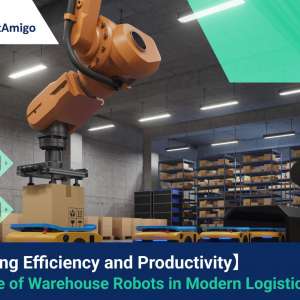Author Name: Tiffany Lee – Marketing Analyst at FreightAmigo
The world is increasingly embracing the concept of the Internet of Things (IoT), a phenomenon that is revolutionizing various sectors, including manufacturing. IoT refers to the interconnection of physical devices, vehicles, buildings, and other items embedded with sensors, software, network connectivity, and necessary electronics that enable these objects to collect and exchange data. This technological advancement is playing a significant role in factory automation, leading to the creation of smart factories.
Factory automation or industrial automation refers to the use of control systems such as computers or robots, and information technologies for handling different processes and machinery in an industry to replace human beings. It is a step beyond mechanization, where human operators are provided with machinery to assist them in their manual work. In the context of factory automation, IoT is being leveraged to streamline and automate manufacturing processes.
The convergence of IoT and factory automation is creating an entirely new paradigm. It’s enabling businesses to control and monitor production processes in real-time, increase operational efficiency, reduce production costs, and improve product quality. However, understanding this convergence and its implications requires a deeper look into factory automation and the role of IoT in it.
Want to compare the best Express, Air Freight, Sea Freight, Rail Freight & Trucking rates so as to have better control on cost?
Understanding Factory Automation
Factory automation is a broad term that encompasses several technologies, including robotics, artificial intelligence, machine learning, and IoT. It involves the use of automation robots and control systems to replace human intervention in a factory. The main goal is to increase productivity, quality, and flexibility while reducing costs.
One of the main components of factory automation is the automation robot. These are programmable machines capable of performing complex series of actions automatically. Automation robots are typically used in manufacturing processes, including assembly lines, painting, material handling, and packaging.
The application of IoT in factory automation, also known as smart factory automation, is changing the traditional manufacturing landscape. It is making factories more efficient and productive by connecting machines and systems. The use of IoT in factory automation is not just about automating processes; it’s about getting data and insights from these processes to make informed business decisions.
Role of the Internet of Things (IoT) in Factory Automation
IoT is playing a pivotal role in factory automation by connecting machines and systems. It’s enabling factories to become smarter and more efficient. IoT devices collect data from various sources, such as machines, systems, and sensors, and then transmit this data over the internet to a central system or cloud for analysis.
This connectivity allows factory managers to monitor and control production processes in real-time, leading to increased efficiency and reduced downtime. For instance, if a machine is about to fail, the IoT system can alert the maintenance team in advance, allowing them to fix the problem before it leads to a costly production halt.
Furthermore, IoT is enabling predictive maintenance in factories. By analyzing the data collected from machines, IoT systems can predict when a machine is likely to fail and schedule maintenance accordingly. This approach reduces unnecessary maintenance costs and minimizes downtime.
Connectivity and IoT: Revolutionizing Factory Automation
Connectivity and IoT are revolutionizing factory automation by enabling real-time monitoring and control of production processes. These technologies are transforming factories into smart manufacturing facilities, where every machine and system is connected and communicating.
IoT is making it possible to collect and analyze data from every corner of the factory. This data is used to optimize production processes, reduce waste, improve product quality, and make factories more energy-efficient. Moreover, the ability to remotely monitor and control machines and systems is making factories safer places to work.
The use of IoT in factory automation is also leading to the development of more flexible manufacturing systems. With IoT, factories can quickly adapt to changes in demand, switch production lines, and customize products without significant downtime or cost.
The Impact of IoT on Automation Robotics
Automation robotics is another area where IoT is making a significant impact. By connecting robots to the internet, factories can remotely monitor and control these machines, leading to increased efficiency and productivity.
The integration of IoT and automation robots is also enabling collaborative robotics, where robots and humans work together in the same environment. IoT technologies allow these robots to sense their environment and react to changes, making them safer and more efficient.
Moreover, IoT is enhancing the capabilities of automation robots. For instance, by analyzing data collected from robots, factories can optimize their operation, reduce wear and tear, and increase their lifespan. IoT is also enabling predictive maintenance for robots, reducing downtime and maintenance costs.
Advantages of Implementing IoT in Factory Automation
Implementing IoT in factory automation comes with several advantages. Firstly, it leads to increased efficiency and productivity. By connecting machines and systems, factories can monitor and control production processes in real-time, reducing downtime and waste.
Secondly, IoT enables predictive maintenance, reducing maintenance costs and minimizing downtime. By analyzing data collected from machines, IoT systems can predict when a machine is likely to fail and schedule maintenance accordingly.
Thirdly, the use of IoT in factory automation leads to improved product quality. By monitoring production processes in real-time, factories can quickly detect and correct any quality issues, leading to higher customer satisfaction.
Moreover, implementing IoT in factory automation makes factories safer. By remotely monitoring and controlling machines and systems, factories can minimize the risk of accidents and injuries.
The Challenges and Solutions in Implementing IoT
Despite the numerous advantages, implementing IoT in factory automation is not without challenges. One of the main challenges is the integration of IoT technologies with existing factory systems. Many factories use old machines and systems that are not compatible with IoT technologies, making integration a complex and costly process.
Another challenge is data security. With the increased connectivity and data exchange, factories become more vulnerable to cyber-attacks. Therefore, factories need to implement robust security measures to protect their data and systems.
Despite these challenges, there are solutions available. For instance, several companies offer IoT platforms that can integrate with existing factory systems, making the transition to IoT easier and more cost-effective. Moreover, advances in cybersecurity are providing factories with the tools and strategies they need to protect their data and systems.
Conclusion
The future of IoT in factory automation looks promising. As technology continues to evolve, the role of IoT in factory automation is expected to grow even further. With the advent of technologies like 5G, AI, and machine learning, the possibilities for IoT in factory automation are virtually limitless.
In the future, factories will become more connected, intelligent, and efficient. They will be able to adapt to changes in demand, customize products, and deliver high-quality products at a lower cost. They will also become safer places to work, with machines and systems that can predict and prevent accidents.
In conclusion, the Internet of Things is revolutionizing factory automation, turning traditional factories into smart manufacturing facilities. By connecting machines and systems, IoT is enabling real-time monitoring and control of production processes, predictive maintenance, and improved product quality. Despite the challenges, the benefits of implementing IoT in factory automation far outweigh the costs, making it a worthwhile investment for any manufacturing business.
There are different options for cargo transportation. If you want to choose the most convenient and suitable solution, it is best to have the full support of logistics experts! If you are planning to ship goods overseas, please go to the FreightAmigo page for inquiries.
===
Read More:
【Embracing Industry 4.0】 The Pivotal Role in Shaping the Future of Factory Automation
【Logistics 101】Impact of Artificial Intelligence in Logistics Automation
===
If you have any inquiries on logistics/supply chain, feel free to contact FreightAmigo now:
Chat with us online OR
Phone : +852 28121686
WhatsApp: +852 27467829









































